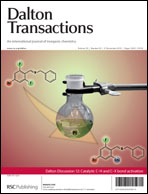Insights into the intramolecular acetate-mediated formation of ruthenium vinylidene complexes: a ligand-assisted proton shuttle (LAPS) mechanism†‡
Abstract
The ![[triple bond, length as m-dash]](https://www.rsc.org/images/entities/char_e002.gif) CPh
CPh![[double bond, length as m-dash]](https://www.rsc.org/images/entities/char_e001.gif) C
C![[double bond, length as m-dash]](https://www.rsc.org/images/entities/char_e001.gif) CHPh)(PPh3)2. An experimental study has demonstrated that this reaction occurs under very mild conditions, with significant conversion being observed at 255 K. At lower temperatures, evidence for a transient
CHPh)(PPh3)2. An experimental study has demonstrated that this reaction occurs under very mild conditions, with significant conversion being observed at 255 K. At lower temperatures, evidence for a transient ![[double bond, length as m-dash]](https://www.rsc.org/images/entities/char_e001.gif) CHPh)(PPh3)2 was obtained. A comprehensive theoretical study to
CHPh)(PPh3)2 was obtained. A comprehensive theoretical study to ![[double bond, length as m-dash]](https://www.rsc.org/images/entities/char_e001.gif) C
C![[double bond, length as m-dash]](https://www.rsc.org/images/entities/char_e001.gif) CHMe)(PH3)2 demonstrate that both the
CHMe)(PH3)2 demonstrate that both the ![[triple bond, length as m-dash]](https://www.rsc.org/images/entities/char_e002.gif) CMe)(PH3)2 and the C–H agostic σ-complex Ru(κ1-OAc)(κ2-OAc)(η2{CH}-HC
CMe)(PH3)2 and the C–H agostic σ-complex Ru(κ1-OAc)(κ2-OAc)(η2{CH}-HC![[triple bond, length as m-dash]](https://www.rsc.org/images/entities/char_e002.gif) CMe)(PH3)2 are minima on the potential energy surface. The lowest energy pathway for the formation of the
CMe)(PH3)2 are minima on the potential energy surface. The lowest energy pathway for the formation of the ![[double bond, length as m-dash]](https://www.rsc.org/images/entities/char_e001.gif) C
C![[double bond, length as m-dash]](https://www.rsc.org/images/entities/char_e001.gif) CHPh)(PPh3)2 reinforce the notion that lowest energy pathway involves the deprotonation/reprotonation of the
CHPh)(PPh3)2 reinforce the notion that lowest energy pathway involves the deprotonation/reprotonation of the ![[double bond, length as m-dash]](https://www.rsc.org/images/entities/char_e001.gif) C
C![[double bond, length as m-dash]](https://www.rsc.org/images/entities/char_e001.gif) CHPh)(PPh3)2 as the thermodynamic product.
CHPh)(PPh3)2 as the thermodynamic product.

- This article is part of the themed collection: Dalton Discussion 12: Catalytic C–H and C–X bond activation (DD12)

 Please wait while we load your content...
Please wait while we load your content...